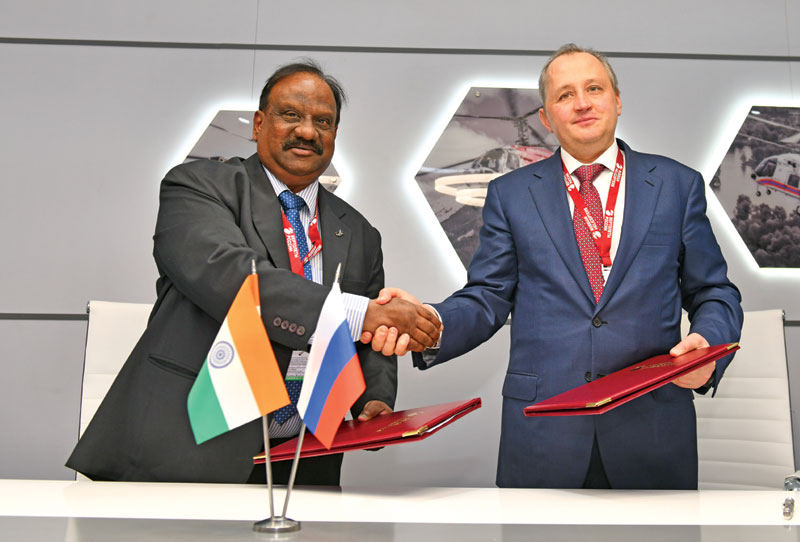IRHL and Russian Helicopters signed a document laying out the roadmap for the production of Kamov-226T in India
Palak Gupta
India’s terms and conditions for a higher Indigenous Content (IC) in the Kamov-226T has stalled the procurement of the Russian light utility helicopters. The more than USD1 billion inter-governmental agreement (IGA) was signed in October 2015 between India and Russia. More than four years later, differences over Transfer of Technology (ToT) remain to be ironed out. As per the initial plans, the first chopper was supposed to be delivered to India in 2021.

In a bid to resolve the existent deadlock, Indo-Russian Helicopters Limited (IRHL) and the Russian Helicopters on 6 February 2020 signed a document laying bare the roadmap for the ‘Transfer of Technology’ with respect to the manufacture of Kamov 226T in India. Incorporated in May 2017 as a part of a project to localise the production of Kamov-226T helicopters, IRHL is a joint venture of Russian Helicopters, Rosoboronexport and the state-owned Hindustan Aeronautics Limited (HAL).
HAL owns 50.5 per cent of the venture, Russian Helicopters, 42.5 per cent and Rosoboronexport, 7 per cent.
The signing ceremony took place on the sidelines of the 11th edition of the recently concluded DefExpo 2020 in Lucknow. “The document outlines the main stages and terms for organising production of the Ka-226T helicopter and its units in India with respect to the date when the corresponding contract will be signed,” Russian Helicopters said in a statement.
“The roadmap signed will be the basis for further development of the Kamov-226T localisation project in India after the signing of the contract,” said Director General of Russian Helicopters holding company Andrei Boginsky.
The roadmap spells out key stages of the project to localise production of the Ka-226T helicopter in India, which includes timelines for transferring design documentation, setting up production in India, contracting with suppliers, supplying technological equipment, training Indian personnel among others.
According to CEO of Indo-Russian Helicopters Limited (IRHL) Madayi Nakkady Shrinath, a detailed and a revised techno-commercial proposal has already been submitted to the Indian ministry of defence (MoD) and a final go-ahead from the Defence Acquisition Council (DAC) for the signing of a formal contract is awaited.
“MoD sought clarity on the indigenous content in the helicopter. Now, we have submitted fresh details regarding it. We are expecting the issue to be resolved soon,” said Shrinath.
The origin of the parts of Ka-226T can be classified into Russian and European. The Russian content is about 74 per cent and the European is 26 per cent, Shrinath shared. It is pertinent to mention that under the IGA, Russia is responsible for localisation of the helicopter production in India but not for its foreign components. Ka-226T’s engine is of French origin, made by aerospace engine manufacturer Safran.
Explaining the nuances of the agreement, Shrinath said that the procurement/production/assembly/localisation plan has a total of four phases. “In Phase 0, 60 Ka-226T will come directly from the RH plant in Ulan Ude in fly-away condition, hence zero indigenous content (IC). However, in the first phase there will be 13.3 per cent IC for 35 helicopters, the second phase will have 15 per cent indigenisation for 25 helicopters, the third phase will have 35 per cent indigenisation for 30 helicopters and the fourth phase will have 62.41 per cent indigenous content for the last 50 helicopters,” said Shrinath.
The initial IC proposed by the MoD in its Request for Proposal (RFP) is 70 per cent. Ka-226T will be manufactured in India at HAL’s newly set up plant in Tumkur district near Bengaluru in Karnataka. The first chopper will arrive from Russia 24 months from the approval of the contract and the ones which will be manufactured indigenously by the HAL, will be delivered 36 months from contract approval.
While, the India-Russia JV IRHL will be responsible for assembly, integration and flying, the project is also expected to witness contribution from several micro, small and medium enterprises which will be divided into separate categories depending on their core strength. Each block will have at least five to six vendors of which the tendering will commence soon.
According to Shrinath, there will be a complete ToT in manufacturing rotors of aircraft.
“India is one of the largest operators of Russian-made rotorcraft, and DefExpo provides an excellent opportunity to discuss further steps in developing our cooperation. Besides, the project aimed at localising the Ka-226T helicopter production, such issues as the supply of new civilian helicopters and maintenance and repair of previously delivered rotorcraft are becoming increasingly important. Today, the fleet of Russian and Soviet-made helicopters in India exceeds 400 units,” said Igor Chechikov, head of the Russian Helicopters delegation, deputy Director General of the Russian Helicopters Holding Company for Aftersales Service.
The Kamov-226T, an Indian-specific variant, is expected to substitute the vintage and obsolete Cheetah and Chetak fleets of the Indian Army and the air force. The chopper has coaxial rotors – a pair of rotors mounted one above the other and is capable of operating in mountainous terrain, hot environment and high altitude.

